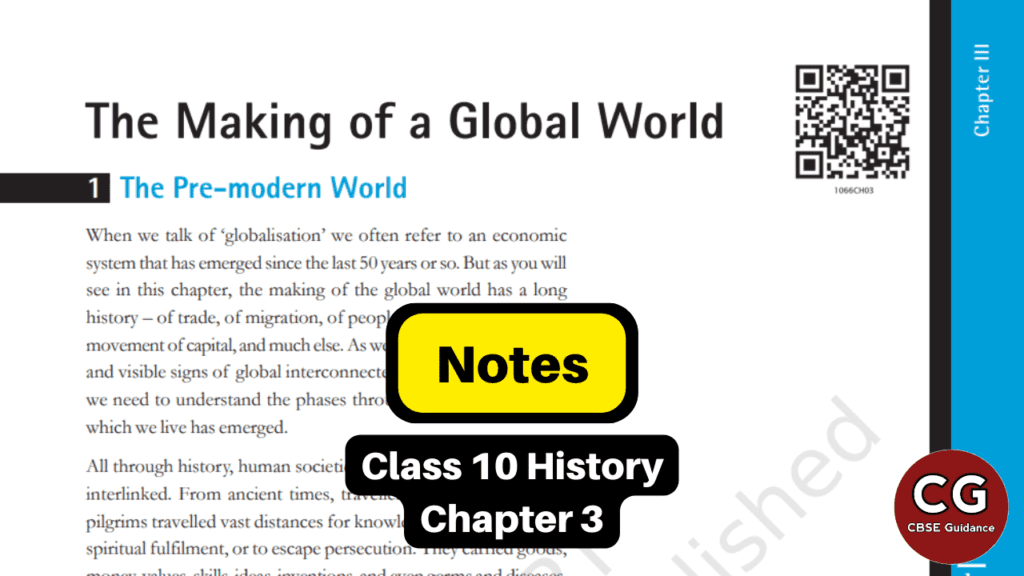Welcome to your go-to resource for Class 10 History Chapter 3, "The Making of a Global World," within the realm of Social Science. Our Class 10 Notes are thoughtfully curated, aligning seamlessly with the CBSE 2024-25 latest syllabus.
All deleted topics from the latest syllabus have been excluded, so you can be confident that you are getting the most up-to-date and relevant information.

| Subject | Social Science (History) |
| Class | 10 |
| Board | CBSE and State Boards |
| Chapter No. | 3 |
| Chapter Name | The Making of a Global World |
| Type | Notes |
| Session | 2024-25 |
| Weightage | 1-2 marks |
"The only way to do great work is to love what you do."
- Steve Jobs
The Making of a Global World Class 10 Notes
Table of Contents
The Pre-modern World
- Globalization is a long-term process, not just a recent phenomenon.
- Trade, migration, the movement of capital, and the spread of ideas and diseases have all contributed to globalization.
- Evidence of globalization can be found as far back as 3000 BCE.
- Cowries from the Maldives were used as currency in China and East Africa for over a millennium.
- The long-distance spread of disease-carrying germs can be traced back to the seventh century.
- By the thirteenth century, globalization was an unmistakable link between different parts of the world.
Silk Routes Link the World
The silk routes are a good example of vibrant pre-modern trade and cultural links between distant parts of the world:
- Historians have identified several silk routes over land and by sea connecting vast regions of Asia with Europe and northern Africa.
- The name ‘silk routes’ points out the importance of West-bound Chinese silk cargoes along this route.
- Chinese pottery also traveled the same route, as did textiles and spices from India and Southeast Asia.
- In return, precious metals (gold and silver) flowed from Europe to Asia.
- Early Christian missionaries and Muslim preachers traveled this route to Asia. Much before all this, Buddhism from Eastern India spread in several directions through intersecting points on the silk routes.
Food Travels: Spaghetti and Potato
- Traders and travelers introduced new crops to the lands they traveled.
- Even ‘ready’ foodstuff in distant parts of the world might share common origins like spaghetti and noodles or, perhaps, Arab traders took pasta to 5th century Sicily, an island now in Italy.
- Similar foods were also known in India and Japan, so the truth about their origins may never be known. Yet such guesswork suggests the possibilities of long-distance cultural contact even in the pre-modern world.
- Many of our common foods such as potatoes, soya, groundnuts, maize, tomatoes, chilies, sweet potatoes, and so on were not known to our ancestors until about five centuries ago.
- These foods were only introduced in Europe and Asia after Christopher Columbus accidentally discovered the vast continent that would later become known as the Americas.
Sometimes the new crops could make the difference between life and death:
- Europe’s poor began to eat better and live longer with the introduction of the humble potato.
- Ireland’s poorest peasants became so dependent on potatoes that when disease destroyed the potato crop in the mid-1840s, hundreds of thousands died of starvation.
Conquest, Disease, and Trade
After the discovery of America, its vast lands and abundant crops and minerals began to transform trade and lives everywhere.
Precious metals, particularly silver, from mines located in present-day Peru and Mexico also enhanced Europe’s wealth and financed its trade with Asia.
European conquest was not just a result of superior firepower:
The Spanish conqueror’s most powerful weapon was not a conventional military weapon because
- they used germs like smallpox which spread deep into the continent before any European could reach there.
- America's original inhabitants had no immunity against these diseases that came from Europe. This disease erased the whole community, leading to conquest. This biological warfare in the mid-sixteenth century made it easy for the Spanish to overpower the Americans.
European flee to America in the 19th century:
- Poverty and hunger were common in Europe.
- Cities were crowded and deadly diseases were widespread.
- Religious conflicts were common and religious dissenters were persecuted.
- Therefore, thousands fled Europe for America where plantations were worked by slaves captured in Africa for growing cotton and sugar for European markets.
| Must Read: The Making of a Global World Class 10 Important Questions Answers The Making of a Global World Class 10 NCERT Underlined PDF |
Hope you liked these Notes on The Making of a Global World Class 10 History. Please share this with your friends and do comment if you have any doubts/suggestions to share.
Please give pdf link of print culture and the modern world and the making of global world
How to Download PDF from CBSE Guidance Website
https://youtu.be/zjocgf0LzUM
hello hogya exam tumhara
Thank you so much sir for your support and hard work…
I really appreciate that 😌